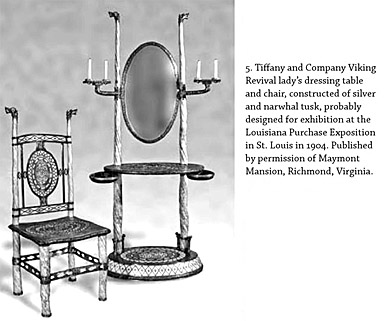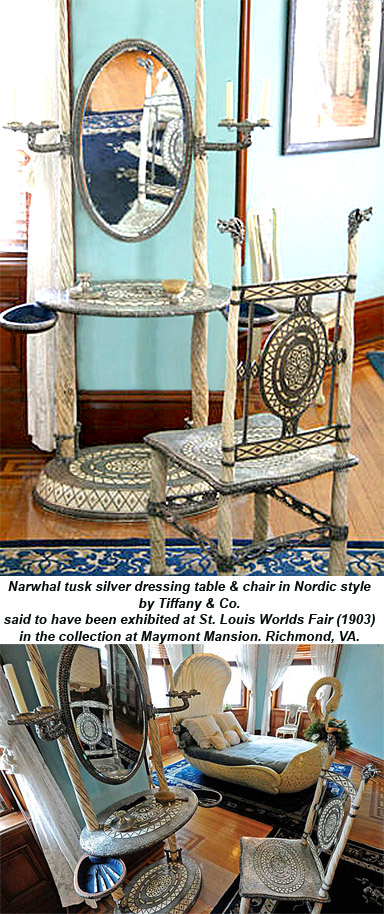quote:
In Search of First Contact: The Vikings of Vinland
the Peoples of the Dawnland,
and the Anglo-American Anxiety of Discovery
By Annette Kolodny
May 29, 2012
210 Chapter Four - pg 210
Sometime after the turn of the century, Tiffany & Company produced two of its most unusual Viking—style pieces: a ladies’ dressing table and matching chair “fashioned from sterling silver and four long, twisting narwhal tusks”. Silver dragonhead finials, reminiscent of the curved prows on Viking long ships, capped the narwhal support tusks on both the chair and the mirrored table. The single tusk of the narwhal (an arctic whale) had long been prized by medieval Scandinavians as a substitute for elephant ivory from Africa and as a material for making everything from sword hilts to royal thrones. As Herman Melville had reminded his readers in Moby-Dick (1851), “In old Norse times, the thrones of the sea loving Danish kings were fabricated, saith tradition, of the tusks of the narwhale”. Thus, as one knowledgeable curator of historical objects observed in 2004, “The use of entire narwhal tusks [as supports of the table and chair] was a particularly brilliant stroke that further heightens the overall Nordic character of the set”. Probably designed for exhibition at the Louisiana Purchase Exposition in St. Louis in 1904, the chair and dressing table were then returned to Tiffany’s New York store and there purchased by Sallie and James Henry Dooley of Richmond, Virginia.“ (See figure 5.) James Dooley, formerly an officer in the Confederate Army, was now one of the major railroad financiers in the post Civil War South. Without question, extravagant pieces like Sallie Dooley’s dressing table and chair came out of the era’s “prevailing affinity for design derived from historical sources, and the ‘conspicuous consumption’ of rich and exotic materials that appealed to the growing class of multimillionaires”. But this affinity for home furnishings designed to replicate historical sources, and especially the emphasis on all things Viking, suggests something else, too. In the absence of inherited family heirlooms and long established family status, some of the newly self made Gilded Age multimillionaires could purchase at least the simulacrum of pedigree and old wealth by surrounding themselves and their families with its representations. The purchase of history and the historical thereby became a valuable palliative for the class conscious and anxious nouveau riche. Moreover, the purchase of Viking Revival pieces, in particular, brought to the home associations with ancient Nordic bloodlines, manly vigor, heroic deeds, and, on a patriotic note, first discovery.

....
quote:
Tiffany Epiphany
The conspicuous consumption of an earlier era lives at Maymont
By Martha Steger
Before any income tax, before any investment regulations — and before any retailers of luxury goods began marketing to the masses, millionaire homeowners James and Sallie Dooley of Maymont mansion were purchasing one-of-a-kind items made by Tiffany and Co., such as the narwhal-whale tusk and silver dressing table and chair.
With the opening of a Tiffany's store in Richmond's Stony Point Fashion Park in September, a company archivist and new store manager visited Maymont as other Tiffany representatives did. Like other visitors, officials of this company, which dates its beginning to Charles Lewis Tiffany's founding in 1837, were there to view the viking revival dressing table and chair in the Dooleys' second-floor room, a place often referred to as the swan room because of the bed designed to resemble a swan.
The mansion stands as an unusually complete document of the taste and lifestyle of the wealthy in the mainstream of the Gilded Age — the type of clientele to which Tiffany catered. With a core collection of 1,000 furnishings and art acquired by the Dooleys for the house on their 100-acre estate, Maymont is the most complete, intact historic site of the period when Tiffany's was the most prestigious source in the country for a full range of luxury items for millionaires.
Maymont's collection joins other notable offerings from the company found in River City, such as Lewis Comfort Tiffany's art on display at the Virginia Museum of Fine Arts, and a Tiffany sword captured from a Union soldier at the Museum of the Confederacy. "Tiffany made nothing for the Confederacy," museum senior curator Robert Holland says. "It was illegal for the Union to trade with the enemy."
Characteristic of the conspicuous consumption of Gilded Age taste, Maymont's examples represent the ultimate expression of Tiffany & Co.'s viking revival style, inspired by the excavation of viking ships in Norway in the 1880s through the early 20th century.
An accessories set, also made by Tiffany, complements the vanity table and chair in the bedroom, though it wasn't discovered until 2008. On a recent tour Dale Cyrus Wheary, director of historical collections and programs for the Maymont Foundation, pointed to some of the 22 pieces of the Tiffany silver-and-ivory set found in a long-sealed drawer: hairbrush, tweezers, large nail file, buttonhook, cuticle pusher, comb, brush, nail buffer, nail scissors, small nail file, cuticle knife and perfume bottle. The cache had remained hidden under the staff's noses.
"As we progressed with implementation of our long-term conservation plan," Wheary recalls, "many locked drawers and cabinets were opened. Although we always hoped to find long-hidden treasures or a cache of Dooley papers, nothing came to light as we conserved the collection piece by piece over the years."
One day, a locksmith was called in to do some work and made the discovery. Wheary was in her third-floor office. "I heard screams of joy coming from downstairs," she says. "As I walked into the room, collections manager Kathy Garrett-Cox and conservation tech Evelyn Zek were unwrapping the treasure trove."
Wheary wrote in a 2008 article for the Magazine Antiques that Tiffany had established the date of the dresser and chair because the set was made for the St. Louis Exposition in 1904. The ensemble's unique design is indicative of the heated competition among designers vying for awards at international expositions at the turn of the century — when Tiffany's Paulding Farnham was the creative genius at the company. Wheary also noted that newspapers used as padding between the mirror and its backing date from 1903 and 1904.
The rare Tiffany items at Maymont include a three-handled silver presentation cup, a fan box and three French clocks sold by the company. These clocks reveal Tiffany's early practice of retailing, under its own brand, items made by others — such as the clock made by the famous French clock maker, Japy Freres and Cie, dating to around 1875.
Whether Maymont's one-of-a-kind items were made by Tiffany or simply marketed by the company under its name, the pieces on display at Maymont stand out individually and as part of a rare collection. Conspicuous consumption lives on, and not just at Stony Point.

 SMP Silver Salon Forums
SMP Silver Salon Forums

 American Sterling Silver
American Sterling Silver

 Tiffany & Company narwhal dressing table & matching chair
Tiffany & Company narwhal dressing table & matching chair








